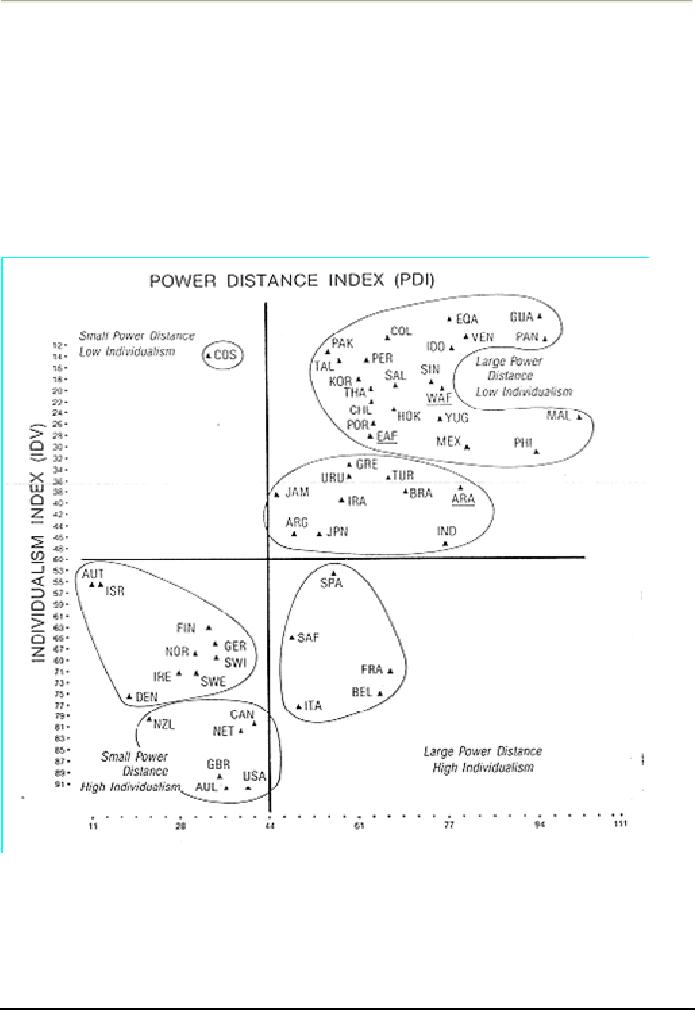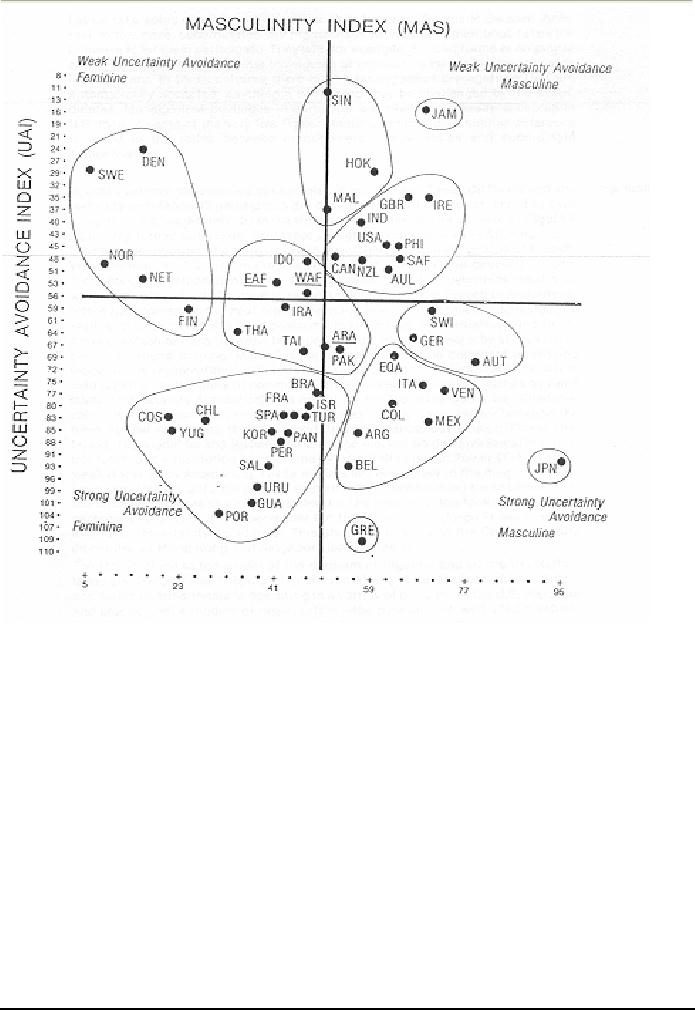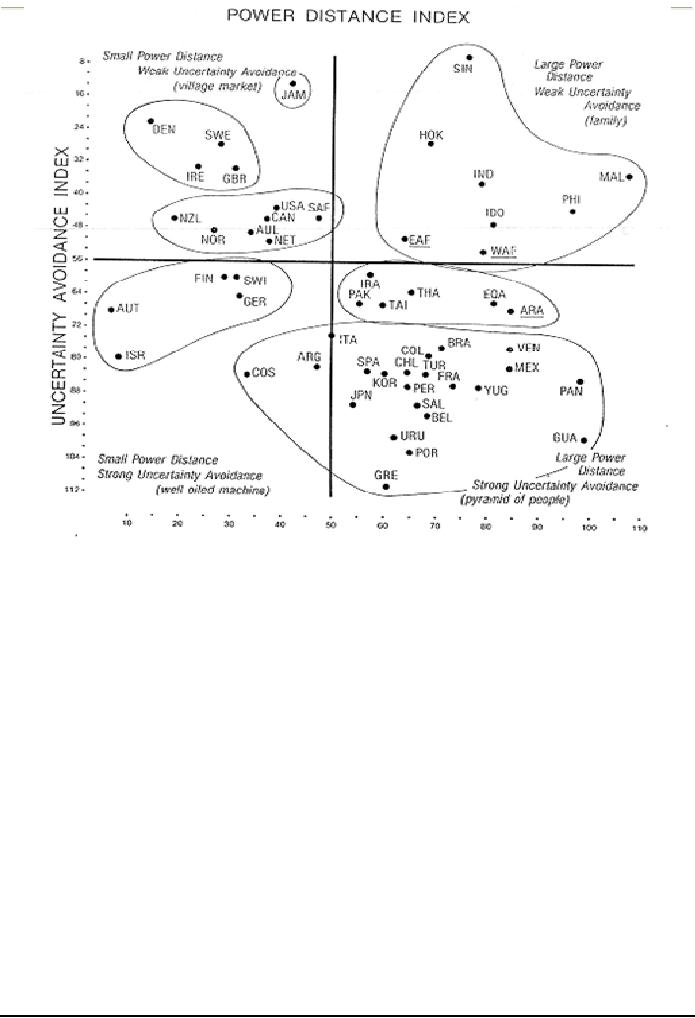 |

Organizational
Psychology (PSY510)
VU
LESSON
04
DEFINING
THE CULTURE
Culture
may be understood as:
·
the
set of common understandings expressed in
language
·
values,
beliefs and expectations
that members come to
share
·
a
system for creating,
sending, storing and processing
information
·
the
collective of the mind which
distinguishes the members of one
group of people from another
The
world culture has been derived
from the Latin word cultura
stemming
from colere, meaning
"to cultivate".
It
generally refers to patterns of
human activity and the
symbolic structures that give
such activity
significance.
Different definitions of "culture"
reflect different theoretical bases for
understanding, or
criteria
for evaluating, human
activity.
Anthropologists
most commonly use the term "culture" to
refer to the universal human capacity to
classify
codify
and communicate their
experiences symbolically. This capacity
has long been taken as a
defining
feature
of the humans. Many observers
have shown that there
are cultural differences
in:
o
Self
perception
Self
perception is how people belonging to different
culture look at themselves. For
example,
in
some cultures people are
viewed as honest while in
other people are cynical about
each
other.
Therefore, they act accordingly taking or
not taking precautionary
measures.
o
Relationship
with world
This
refers to the inclination of the people to dominate
their environment to,
perhaps extract
the
most out of it. Further, it
also refers to the acceptability of
other cultures. In simpler
terms,
relationship
with the world refers to the
terms that people have with
their environment and
the
rest
of the world.
o
Time
Dimension
Time
dimension refers to the past, present or
future orientation of the people in a culture.
It
means
that people in a particular culture may either be
concerned about their future or
present
or
past. The Japanese culture is a
future oriented while the American
culture is considered to be
a
present oriented.
o
Public
and private space
In
some cultures, people prefer to be
sitting alone in their
cabins at their workplace,
while in
other
cultures, people tend to inclined
towards common working space
where they sit together
and
work. Therefore, the public or private
space orientation is also a
differentiating feature of
cultures.
Key
Components of Culture
A
common way of understanding culture sees it as
consisting of four elements
that are "passed on
from
generation
to generation by learning alone":
1.
Values
2.
Norms
3.
Institutions
4.
Artifacts
Values
comprise ideas about what in
life seems important. They
guide the rest of the culture. Norms
consist
of
expectations of how people will
behave in various situations.
Each culture has methods,
called sanctions,
of
enforcing its norms.
Sanctions vary with the importance of the
norm; norms that a society
enforces
formally
have the status of laws.
Institutions are the structures of a
society within which values
and norms
are
transmitted. Artifacts are things, or
aspects of material culture.
Organizational
Culture
Just
as a country has a culture, organizations
also have culture which is influenced by
the national culture.
With
respect to cultural differences affecting
organizational psychology, two major researches
need to be
quoted:
·
Geert
Hofstede's research; and
·
Trompenaar's
Research
10

Organizational
Psychology (PSY510)
VU
Geert
Hofstede's Research
Hofstede
researched on 116,000 workers of IBM
spread over 70 countries
world wide. He discovered
that
organizational
culture differs in the following four
terms:
·
Power
distance (acceptance of other's
power)
·
Masculinity/Femininity
·
Indvidualism/collectivism
·
Uncertainty
avoidance
Power
Distance Index (PDI) that
is the extent to which the less powerful
members of organizations
and
institutions
(like the family) accept and
expect that power is distributed
unequally. This represents
inequality
(more
versus less), but defined
from below, not from
above. It suggests that a
society's level of inequality is
endorsed
by the followers as much as by the
leaders. Power and
inequality, of course, are
extremely
fundamental
facts of any society and
anybody with some international
experience will be aware
that 'all
societies
are unequal, but some
are more unequal than
others'.
Individualism
(IDV) on the
one side versus its
opposite, collectivism, that is the degree to
which
individuals
are integrated into groups. On the
individualist side we find
societies in which the ties
between
individuals
are loose: everyone is
expected to look after him/herself
and his/her immediate
family. On the
collectivist
side, we find societies in
which people from birth
onwards are integrated into
strong, cohesive
in-groups,
often extended families
(with uncles, aunts and
grandparents) which continue
protecting them in
exchange
for unquestioning loyalty. The
word 'collectivism' in this sense has no
political meaning: it
refers
to
the group, not to the state. Again, the
issue addressed by this dimension is an
extremely fundamental one,
regarding
all societies in the
world.
11

Organizational
Psychology (PSY510)
VU
Masculinity
(MAS) versus
its opposite, femininity refers to the
distribution of roles between the
genders
which
is another fundamental issue for any
society to which a range of solutions
are found. The IBM
studies
revealed that (a) women's
values differ less among
societies than men's values; (b)
men's values from
one
country to another contain a dimension from very
assertive and competitive
and maximally different
from
women's values on the one
side, to modest and caring
and similar to women's
values on the other.
The
assertive pole has been
called 'masculine' and the
modest, caring pole 'feminine'.
The women in
feminine
countries have the same
modest, caring values as the
men; in the masculine countries they
are
somewhat
assertive and competitive, but
not as much as the men, so
that these countries show a
gap
between
men's values and women's
values. The following table
shows some of the basic
characteristics of
Feminine
and Masculine societies.
Feminine
societies
Masculine
societies
Assertiveness
ridiculed
Assertiveness
appreciated
Undersell
yourself
Oversell
yourself
Stress
on life quality
Stress
on careers
Intuition
Decisiveness
12

Organizational
Psychology (PSY510)
VU
Uncertainty
Avoidance Index (UAI) deals
with a society's tolerance
for uncertainty and ambiguity; it
ultimately
refers to man's search for
Truth. It indicates to what extent a culture
programs its members
to
feel
either uncomfortable or comfortable in unstructured
situations. Unstructured situations are
novel,
unknown,
surprising, and different
from usual. Uncertainty
avoiding cultures try to minimize the
possibility
of
such situations by strict laws
and rules, safety and
security measures, and on the
philosophical and
religious
level by a belief in absolute Truth;
'there can only be one
Truth and we have it'.
People in
uncertainty
avoiding countries are also
more emotional, and motivated by
inner nervous energy.
The
opposite
type, uncertainty accepting cultures, are
more tolerant of opinions
different from what they
are
used
to; they try to have as few
rules as possible, and on the
philosophical and religious level they
are
relativist
and allow many currents to
flow side by side. People
within these cultures are
more phlegmatic and
contemplative,
and not expected by their
environment to express
emotions.
13

Organizational
Psychology (PSY510)
VU
Long-Term
Orientation (LTO) versus
short-term orientation: this fifth dimension
was found
in
a study among students in 23
countries around the world, using a
questionnaire designed by
Chinese
scholars It can be said to
deal with Virtue regardless
of Truth. Values associated
with
Long
Term Orientation are thrift
and perseverance; values
associated with Short
Term
Orientation
are respect for tradition,
fulfilling social obligations, and
protecting one's 'face'.
Both
the
positively and the negatively rated
values of this dimension are found in the
teachings of
Confucius,
the most influential Chinese
philosopher who lived around
500 B.C.; however, the
dimension
also applies to countries
without a Confucian heritage.
14

Organizational
Psychology (PSY510)
VU
The
following table shows the
ratings for some countries
of the world on Hofstede's
dimensions:
Country
PDI
IDV
MAS
UAI
LTO
Arab
World
80
38
52
68
Australia
36
90
61
51
31
Canada
39
80
52
48
23
China
80
20
66
30
118
Denmark
18
74
16
23
France
68
71
43
86
Germany
35
67
66
65
31
Hong
Kong
68
25
57
29
96
India
77
48
56
40
61
Indonesia
78
14
46
48
Israel
13
54
47
81
Italy
50
76
70
75
Japan
54
46
95
92
80
Malaysia
104
26
50
36
Mexico
81
30
69
82
Netherlands
38
80
14
53
44
New
Zealand
22
79
58
49
30
Norway
31
69
8
50
20
Pakistan
55
14
50
70
0
Russia
93
39
36
95
Singapore
74
20
48
8
48
South
Korea
60
18
39
85
75
Sweden
31
71
5
29
33
Switzerland
34
68
70
58
Taiwan
58
17
45
69
87
United
Kingdom
35
89
66
35
25
United
States
40
91
62
46
29
Trompenaar's
Research
Trompenaar's
research comprised 15000
managers in 28 countries. Having
researched and
written
extensively
on how reconciling cultural differences
can lead to competitive
advantage, Fons Trompenaars
is
now
widely recognised as a leading
authority on organisational culture.
To
Fons Trompenaars, knowledge management
is, or should be, fundamentally a cultural
issue. "Data
becomes
meaningful when you structure it in a
certain way it becomes
information. When you
structure
15

Organizational
Psychology (PSY510)
VU
information,
it becomes knowledge, and when you
structure knowledge it becomes science,
it is the process
of
structuring that adds meaning.
And since different cultures
have different ways of structuring
meaning,
you
can see that, by definition, knowledge
management is a cultural construct."
He
identified the following dimensions of
culture:
o
Universalism/Particularism
practices applied universally and in particular
countries
o
Individualism/collectivism
o
Neutral/Affective:
emotions held in control; affective
cultures emotions are openly
expressed.
o
Specific/diffuse:
differences in public/private space
sharing.
o
Achievement/Ascription:
stress of a person on his
work/achievement, or stress on who
a
person
is
The
first of these he identifies as the
universal versus the particular, a
dilemma that he explores in
great
depth
in his book, Did the
Pedestrian Die? "Imagine you're going in
a car, you're friend is speeding
and he
hits
a pedestrian. You come to court,
and your friend's lawyer
tells you not to worry, as
you were the only
witness.
You know he was speeding,
but what right does your
friend have to ask you to
lie? Would you do
so?"
This is a question that vividly
demonstrates the divide between
universalist and particularist
thinking.
Trompenaars's
research has revealed that
92 per cent of Americans,
for example, would fall
into the
universalist
camp: respect to the truth
and to the law overrides any
notion of there being exceptions to
the
rule.
Conversely, the majority of those in
South Korea, Venezuela and
France (and indeed most of
the Latin
world)
would tend to a more particularistic
standpoint: in Trompenaars's experience,
most ask for
more
information
before they are able to decide whether
they would lie for their
friend, the most common
question
being, did the pedestrian
die?
In
a corporate context, this cultural dilemma raises
obvious difficulties for a knowledge
manager,
particularly
those operating in a multinational organization.
Even on a functional level, it is a disparity
that
needs
to be addressed. As Trompenaar says,
while HR, finance and
marketing professionals are
generally
Universalist
in their outlook, salespeople tend to be
more particularist they invariably
demand exceptions
for
their clients, for example.
For a KM system to succeed, therefore, it
must reconcile the
two.
Implementing
a standardized system in every
office around the world and
across functions will
isolate the
particularist,
just as allowing every office
and department to develop their own
approach to KM will lead
to
chaos.
"Mass customization is the reconciliation of the
universal and the particular," he
says. "You will
not
solve
knowledge management through one
approach alone; it's about how
you combine the two."
The
second of Trompenaar's five dimensions is
the individual versus the team,
which is closely aligned
to
the
third: specific and codified
versus diffuse and implicit knowledge. He
himself relates "a short time ago
we
worked with General Motors to
help integrate its joint
venture with Isuzu, a Japanese
truck-producing
firm.
Because their knowledge was so
individualized, the Americans spent
about 30 per cent of their
time
codifying
their knowledge and writing it up in
handbooks and procedures. The
Japanese, on the other
hand,
never
wrote anything down. Their
knowledge was stored in the network of
their relationships. This
infuriated
the Americans, but in a group-oriented
culture, you need other ways
of communicating
knowledge.
Whereas in an individualized society,
there is a tendency to keep knowledge
because knowledge
is
seen as power, in Japan, knowledge is
only knowledge when it is shared; your
status is dependent on
how
much
you contribute to the
group."
Eventually,
GM's managers succeeded in
convincing their Japanese
counterparts to compile more
concise,
less
time-consuming manuals, which went
some way to satisfying both
parties, but the challenge
of
reconciling
the individual and the group, particularly in an
international organization, is
clear.
The
last of Trompenaars's five
dimensions of knowledge management
relates to the disparity between
perceptions
from the top down and
from the bottom up. "Data
about clients and products
is stored in the
heads
of individual staff members," he says.
"Middle management translates it
into information that in
turn
is
organized as knowledge by top management.
For effective KM, the reconciliation of this
dilemma can be
found
in `middle-up-down', in which middle
management is the bridge between the
standards of top
management
and the chaotic reality of those on the
front line," he says. It can
also be reconciled by the
`servant
leader', he continues, a leader
who connects the bottom with
the top through the style
with which
he
or she leads, drawing their
authority by serving the community as a whole. In
Trompenaars's view, this is
an
approach Goldman Sachs seems
to have mastered.
16

Organizational
Psychology (PSY510)
VU
REFERENCES
·
Trompenaars,
F., Did the Pedestrian Die?
(Capstone Publishing, 2003)
·
Trompenaars,
F. & Hampden-Turner, C., 21 Leaders
for the 21st Century (Capstone Publishing,
2001)
·
Geert-Hofstede's
research:http://www.geert-hofstede.com/geert_hofstede_resources.shtml
·
Detailed
article on defining culture:
http://courses.ed.asu.edu/margolis/spf301/definitions_of_culture.html
FURTHER
READING
·
Dictionary
of the History of Ideas: "culture"
and "civilization" in modern
times:
http://etext.lib.virginia.edu/cgi-local/DHI/dhi.cgi?id=dv1-73
·
Countries
and their Cultures:
http://www.everyculture.com/
·
Global
Culture Essays on globalization,
migration and their impact
on global culture: http://global-
culture.org/
·
What
is Culture? - Washington State
University:
http://www.wsu.edu/gened/learn-
modules/top_culture/culture-index.html
·
Define
Culture - List of definitions of culture
from people around the world:
http://www.defineculture.com/
·
Arnold,
Matthew. 1869. Culture and
Anarchy. New York:
Macmillan. Third edition,
1882, available
online.
Retrieved: 2006-06-28.
·
Forsberg,
A. Definitions of culture CCSF Cultural
Geography course notes. Retrieved:
2006-06-29.
http://fog.ccsf.cc.ca.us/~aforsber/ccsf/culture_defined.html
17
Table of Contents:
- INTRODUCTION TO ORGANIZATIONAL PSYCHLOGY:Hawthorne Effect
- METHODOLOGIES OF DATA COLLECTION:Observational method, Stability of Measures
- GLOBALIZATION:Aspects of Globalization, Industrial Globalization
- DEFINING THE CULTURE:Key Components of Culture, Individualism
- WHAT IS DIVERSITY?:Recruitment and Retention, Organizational approaches
- ETHICS:Sexual Harassment, Pay and Promotion Discrimination, Employee Privacy
- NATURE OF ORGANIZATIONS:Flat Organization, Neoclassical Organization Theory
- ORGANIZATIONAL CULTURE:Academy Culture, Baseball Team Culture, Fortress Culture
- CHANGING ORGANIZATIONAL CULTURE:Move decisively, defuse resistance
- REWARD SYSTEMS: PAY, Methods of Pay, Individual incentive plan, New Pay Techniques
- REWARD SYSTEMS: RECOGNITION AND BENEFITS, Efficiency Wage Theory
- PERCEPTION:How They Work Together, Gestalt Laws of Grouping, Closure
- PERCEPTUAL DEFENCE:Cognitive Dissonance Theory, Stereotyping
- ATTRIBUTION:Locus of Control, Fundamental Attribution Error
- IMPRESSION MANAGEMENT:Impression Construction, Self-focused IM
- PERSONALITY:Classifying Personality Theories, Humanistic/Existential
- PERSONALITY ASSESSMENT:Standardized, Basic Categories of Measures
- ATTITUDE:Emotional, Informational, Behavioural,Positive and Negative Affectivity
- JOB SATISFACTION:The work, Pay, Measurement of Job Satisfaction
- MOTIVATION:Extrinsic motive, Theories of work motivation, Safety needs
- THEORIES OF MOTIVATION:Instrumentality, Stacy Adams’S Equity theory
- MOTIVATION ACROSS CULTURES:Meaning of Work, Role of Religion
- POSITIVE PSYCHOLOGY:Criticisms of ‘Traditional’ Psychology, Optimism
- HOPE:Personality, Our goals, Satisfaction with important domains, Negative affect
- EMOTIONAL INTELLIGENCE:EI IS Related To Emotions and Intelligence
- SELF EFFICACY:Motivation, Perseverance, Thoughts, Sources of Self-Efficacy
- COMMUNICATION:Historical Background, Informal-Formal, Interpersonal Communication
- COMMUNICATION (Part II):Downward Communication, Stereotyping Problems
- DECISION MAKING:History, Personal Rationality, Social Model, Conceptual
- PARTICIPATIVE DECISION MAKING TECHNIQUES:Expertise, Thinking skills
- JOB STRESS:Distress and Eustress, Burnout, General Adaptation Syndrome
- INDIVIDUAL STRESSORS:Role Ambiguity/ Role Conflict, Personal Control
- EFFECTS OF STRESS:Physical Effects, Behavioural Effects, Individual Strategies
- POWER AND POLITICS:Coercive Power, Legitimate Power, Referent Power
- POLITICS:Sources of Politics in Organizations, Final Word about Power
- GROUPS AND TEAMS:Why Groups Are Formed, Forming, Storming
- DYSFUNCTIONS OF GROUPS:Norm Violation, Group Think, Risky Shift
- JOB DESIGN:Job Rotation, Job Enlargement, Job Enrichment, Skill Variety
- JOB DESIGN:Engagement, Disengagement, Social Information Processing, Motivation
- LEARNING:Motor Learning, Verbal Learning, Behaviouristic Theories, Acquisition
- OBMOD:Applications of OBMOD, Correcting Group Dysfunctions
- LEADERSHIP PROCESS:Managers versus Leaders, Defining Leadership
- MODERN THEORIES OF LEADERSHIP PROCESS:Transformational Leaders
- GREAT LEADERS: STYLES, ACTIVITIES AND SKILLS:Globalization and Leadership
- GREAT LEADERS: STYLES, ACTIVITIES AND SKILLS:Planning, Staffing